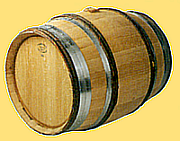|
Rinsing and cleaning
As
soon as a barrel is empty of wine, it must be cleaned in depth in order
to avoid moulds and acetobacterial deterioration. It is necessary to
rinse with a lot of water, and then the simplest method to remove the
deposits adhering to the internal surfaces is to use, as traditionally,
a chain that must be free of oxidation trace or in stainless steel.
It is enough to rinse with water, to leave it drain and to dry 5 to 7
days before sulphuring and then to re-close it tightly.
Never leave water in a barrel because it would become quickly stagnant
or putrid.
|
|
Cleanliness of a used barrel
When
a barrel has not been used for a long time, it is indispensable to
sterilize it, because it must be clean (sterile) and must not bring any
bad odors. Scalding, even with boiling water, is insufficient ; the
temperature is not high enough to ensure the destruction of ferments.
Steaming by injection of steam (under pressure 4 atmospheres or 5 kgs)
gives excellent results.
Steam condenses on the internal surface of
the barrel and ensures a rinsing and raise the interior surface to a
high temperature that destroys the ferments contained. Not to exceed
one half hour of injection.
Rinse then with cool water and drain it carefully.
|
|
Mouldy barrel
Ordinary
bacteria and moulds can accommodate themselves in the depths of the
wood pores.
Even with a good processing, one risks a serious alteration of the wine.
It is necessary
to stave in (to open) the barrel. Brush the internal surface with the
helps of a hard scrubbing brush and a solution of 10% of washing soda
and hot water. Then, steam to destroy the germs.
If you do not have a steaming installation, take care to clean with a
5% dilution of sulphuric acid and hot water
|
|
Sour barrel
A sour barrel becomes
inappropriate to contain wine. it is the acescence. Nevertheless, it
can be treated chemically.
It is sufficient to saturate the acetic acod by an alakaline substance.
Dampen the wood filling with cool water and keep stay during 24 at 48
hours.
Then,
replace it inside with 1 kg of washing soda per hectoliter dissolved in
5 L of boiling water. Move the barrel in all senses and keep it in
contact during 12 hours.
Empty the solution then, and rinse with cool water.
The soda solution saturates the acetic acid and forms with it a soluble
salt that the repeated washings with cool water remove.
It
is possible to use caustic soda or potassium, 100 to 125 grs per
hectoliter of capacity, but often deposits of these products remains
that can be dissolved then in the wine.
Complete by a steaming treatment. This will destroy the germs of the
acescence.
Is
the treatment is not sufficient, and if a bad taste persists, put in 1
liter of ammonia and shake the barrel in all senses. Let it rest 2
times 24 hours. Fill it with cold water and rinse again to suppress the
ammonia taste.
At this moment water can be drained, and the barrel will be well
sterilized.
|
|
Barrel sulphuring
Sulphuring
creates an antiseptic atmosphere ensuring a good conservation of the
barrels. Sulphur wick when burning consumes the oxygen eliminating the
danger of moulds or bacteria and sterilizes the inside at the same time.
Burnin
a quarter of a sulphur wick or 1 gram of sulphur per 10 liters of air
is sufficient. If the sulphur wick doesn't burn, it is certainly
because the barrel contains carbonic acid coming from fermentations or
too much acetic acid.
Barrels empty of wine must be sulphured
imperatively every month. After space every 3 months because the SO2
excess forms SO3 and even SO4 and the chemical reaction creates the
acetic acid.
|
|
|
